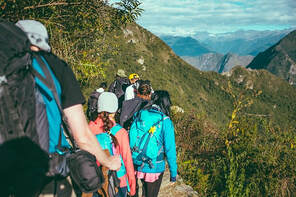English materials for
Secondary school in México
Secondary school in México
First Grade
Unit 10
Lesson plan
Lesson plan | Worksheets & Handouts | PowerPoint presentations
Exercises for students | Project Ideas | Pop Quizzes & Exams
Exercises for students | Project Ideas | Pop Quizzes & Exams
|
Introduction (10 mins.) T writes a few discussion points on the board about traveling:
Development (20 mins.) T writes on the board a list of travel options and asks Ss to classify them into 4 categories (where to go, how to travel, where to stay & what to do). Here are some travel options: a city, by plane, go shopping, a hotel, sightseeing, taking pictures, by train, on foot, the beach, a tent, the mountains, wildlife, an apartment, the river, water sports, practicing extreme sports & hostel. T writes on the board some travelers’ preferences and asks Ss to name travel destinations for each case: Someone who likes…
In pairs, Ss discuss which travel destinations are more expensive, exotic, dangerous, interesting & cheaper. Ss writes their answers on their notebook. Ss may include arguments to support their ideas. T invites volunteers to come to the front of the class and share their ideas. Closure (5 mins.) T reads aloud to the class the achievements for this unit and encourages Ss to share their ideas about the meaning of each achievement. Ss say their expectations they have of the unit. Introduction (5 mins.) T asks Ss to share the information about travel destinations that they brought for the class and asks them where they got that information. T shows some flash cards of sources of information for traveling (brochure, travel guide book, flyer, travel website, travel magazine & travel TV shows) to elicit the vocabulary for the class. Development (20 mins.) T writes on the board some extracts for traveling and asks Ss to identify the source of information for each case:
T invites Ss to discuss what is the best source for the following cases:
T reads aloud several true/false statements of key points from the session and asks Ss to say if they are true or false. Here are some statements:
|
|
|
Introduction (10 mins.) T invites Ss to brainstorm ideas about the most visited cities by international tourists in the world (for example, Paris, Hawaii, Buenos Aires, Puebla, etc.) and why they become so popular destinations. T writes Ss’ ideas on the board. Development (20 mins.) In pairs, Ss choose a travel destination they like and discuss why it could be the best option based on the information consulted in the research. In order to complete the task, Ss write on their notebooks the following information required:
Consolidation (15 mins.) T asks volunteers to come to the front of the class and share their information about the travel destination. Closure (5 mins.) T asks Ss to rank the travel destinations according to their interests. Introduction (10 mins.) T writes on the board a list of adjectives and asks Ss to classify them into 2 categories: beach and mountains. Here are some adjectives: warmer, sandy, rocky, sunny, shady, crowded, cooler, secluded, dry, humid & fresh. T tells Ss that there are many factors affecting how someone spends time his/her time during traveling. These are pros and cons. Development (10 mins.) T writes on the board a list of factors of travel destinations and asks Ss to identify if they are pros (P) or cons (C).
First, T writes 3 travel destinations on the board. Then, T put Ss into teams of 4. Next, T asks Ss to complete a graphic organizer to describe the pros and cons for each location. Also, Ss have to write arguments to choose the best travel destination. Closure (10 mins.) T asks a volunteer from each team to come to the front of the class and explain which travel destination is the best for them and why. |
|
|
Introduction (5 mins.) T writes on the board a text about a tourist spot and asks Ss to underline the comments and arguments about the place. Development ( 15 mins.) T teaches to Ss expressions to describe opinions (I think, I believe, etc.), to express sequence (Firstly, secondly, and finally), and to show contrast (but and however). T gives Ss examples. Consolidation ( 15 mins.) In pairs, Ss choose another tourist spot and write a short text to express their opinions using what they have learned. Closure ( 15 mins.) Volunteers come to the front of the class and read aloud their comments, arguments and conclusions. Introduction (5 mins.) T shows a picture of a tourist spot and asks Ss to answer the following questions:
T writes on the board information about the tourist spot. Ss have to identify which ones are true or false. Consolidation ( 25 mins.) T puts Ss into small teams. Then, T tells Ss that they have to create a 5-day trip for that place. Ss write their itinerary by day. Ss contrast and discuss their ideas with others. Ss present their work in front of the class. Closure ( 5 mins.) T asks Ss to vote for the best trip. |
|
|
Ss develop their final product. First, Ss have to brainstorm travel destinations. Then, Ss have to list activities for each travel destination. After that, Ss take turns giving arguments for and against (pros and cons) the destinations and decide one to work. Then, Ss design a travel itinerary by days and time. Finally, Ss present the itinerary orally. |
|

